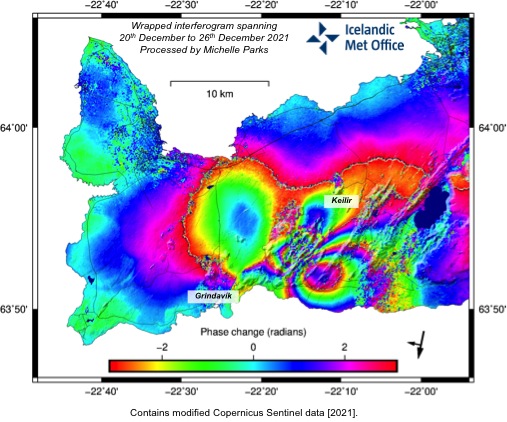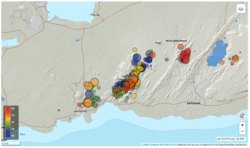Update on the earthquake swarm in Geldingadalir
Intense seismic swarm started
Please view this page for the latest information on seismic activity.
Update on 29.12. at 11:53
Since midnight around 90 earthquakes have been detected. Yesterday there were around 1300 earthquakes detected in the Reykjanes peninsula as a whole. This is a lot less than the day before when around 2300 earthquakes were detected.
The scientific Advisory board for the civil protection services met on the 27th of December to go over the situation near Fagradalsfjall. GPS instruments and satellite interferograms show that the magmatic intrusion is limited to a dike intrusion by Fagradalsfjall, similarly as in February and March 2021 before the eruption onset on the 19th of March. In the event of a new eruption an onset time and location are highly uncertain, therefore it is not recommended to enter the area close to the previous eruption, until further developments.
In these circumstances there is more possibilities of falling rocks in the area and people are advised to be careful in steep hills and stay away from areas where there is a possibility of fallen rocks.
Update on 26.12. at 15:20
The earthquake swarm that started on 21st of December near Fagradalsfjall has continued over the Christmas holidays. Around 3000 earthquakes have been detected every day since the swarm started. Most of the activity is near Fagradalsfjall volcano but earthquakes have also been detected near the town of Grindavík and lake Kleifarvatn. The earthquakes near Grindavík and Kleifarvatn are interpreted as triggered earthquakes due to increased pressure caused by a dike intrusion near Fagradalsfjall. On Christmas eve three earthquakes above M4 were detected near Grindavík, the largest one M4.8. There are no signs of magmatic intrusions in other places than by Fagradalsfjall. The earthquake activity by Fagradalsfjall is episodic with periods of very intense earthquake activity.

Latest InSAR images show clear signs of deformation over the period from 20 to 26 December. The deformation seen now is very similar to deformation observed in the end of February this year when a dike intrusion was starting near Fagradalsfjall. This InSAR data supports data from GPS measurements showing deformation in the same area.
22.12.
No new lava flows have been detected at the crader in Fagradalsfjall for the past three months. Uplift is still ongoing in the area and the scientists are currently working on modelling the ongoing processes and identifying the possible scenarios.
„It can be difficult to say with some accuracy when an eruption is finished, because the volcanic activity can be intermittent“ says Sara Barsotti coordinator for Volcanic Hazards at IMO. „Before the eruptive activity in Geldingadalir started, the Reykjanes peninsula has been very active in terms of seismic activity and magmatic unrest. As we know from the past, when the peninsula is reactivated, episodic eruptions might occur as a series“ says Sara.
Three months has gone since no new lava was produced from the main crader in Geldingadalir, so the eruption that started on the 19th of March lasted for about six months and can be considered closed. Deformation data show that there is still magma inflow in the crust by Fagradalsfjall so it is difficult to predict how the situation will evolve. „ We continue to monitor the Reykjanes peninsula closely but we can say that the specific eruption that started on the 19th of March got to an end. However, even though this episode is closed, we know the activity in the area is still ongoing and other eruptive phases might start in the near future“ says Sara.
IMO is monitoring the area closely and at 18:00UTC last night (21. Dec) a seismic swarm started 2-4 km NE of Geldingadalir. The activity then increased around 00:30UTC and it is still very active with 1-10 earthquakes per minute. Later in the night the activity shifted closer to the volcano in Geldingardalir. This activity can be explained as magma intruding in the crust. There are currently no indication of volcanic tremor in the area.
Up to this point this seismic swarm counted around1.400 automatically detected earthquakes and 90 of these are larger than M2. The largest earthquake was M4,9 and occurred at 09:23UTC at about 2 km SW of Geldingadalir.
Due to the elevated seismic activity the aviation color code has been raised from yellow to orange.




